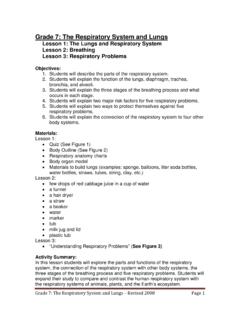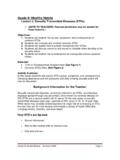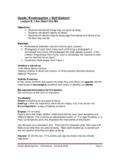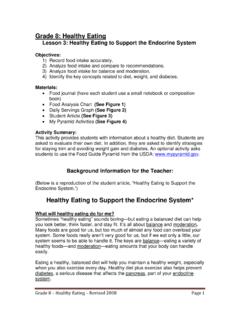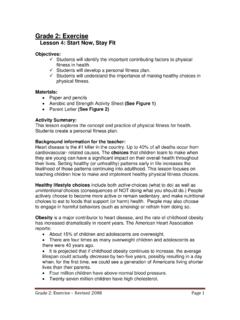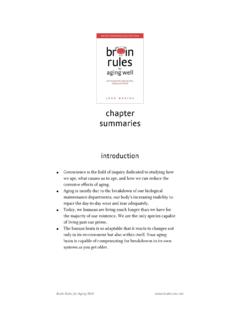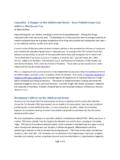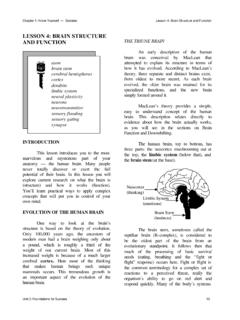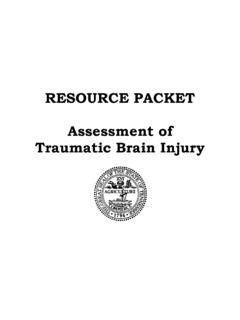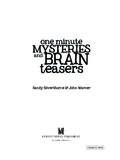Transcription of Grade 5: The Brain and Nervous System Lesson 1: The Brain ...
1 Grade 5: The Brain and Nervous System Lesson 1: The Brain & Nervous System Lesson 2: Brain Connections - Memory, Learning, and the Stress Response Objectives: 1. Students will identify three major structures of the Nervous System . ( Brain , spinal cord, nerves). 2. Students will identify three parts of a neuron. (Cell body, dendrites, axon). 3. Students will understand how the Nervous System affects memory, learning, and the stress. Optional: 4. Students will identify four major structures of the Brain . (Cerebrum, Cerebellum, Brain stem, cerebral cortex). 5. Students will identify four of the six major divisions of the Nervous System .
2 (Central & peripheral; somatic & autonomic; sympathetic & parasympathetic). 6. Students will identify one function of each of the four divisions of the Nervous System . Materials: Lesson 1: Items that can be quietly dropped. Enough for the class. (Examples: soft ball, tennis ball, etc ). Drawing paper Pencils Fruit such as apple, banana, orange. (1 piece of fruit for every 5 students.). Poster board Material to make Learning Station models (Tape, glue, string, wire, modeling clay, colors, tubes, beads, cardboard). Container- any kind Notes with the following information written on them.
3 O From Brain to hand Pick up container (motor instruction). o From hand to Brain The container feels very HOT. (Sensory feedback). o From Brain to hand Drop container! (Motor instruction). Pins or tape Lesson 2: 2 Teacher Aids, parents or volunteers Simple picture to put on the overhead Simple story to read Parent Letter (See Figure 1). Article (See Figure 2). Graphic organizer, Nervous System Activity and The Brain (See Figure 3). Graphic organizer, Memory and Learning (See Figure 4). Answer Keys for the graphic organizers are included at the end of the Lesson (See Figure 5 and Figure 6).
4 Children's Literature: The Brain : Our Nervous System By Seymour Simon Activity Summary: In this Lesson students will acquire a basic understanding of the Brain and Nervous System and how the Nervous System functions in memory, learning, and the stress response. Students will use this foundation to develop understanding of Brain and Nervous System health in their own body. Background information for the teacher: Overview All organs in each body System must work together within that System , and every body System must work together with every other body System for humans to function.
5 The Nervous System coordinates each body System within its own System and with the other systems. All movements and sensations as well as thoughts, emotions, and memory are controlled by the Nervous System . Since conditions within and without the body are constantly changing, the Nervous System monitors changes or stimuli, stores information and/or initiates response impulses throughout affected body systems for action and sensation, emotion, thought, and memory. What is the Nervous System The Nervous System is made up of the Brain , the spinal cord, and a vast network of nerves throughout the whole body.
6 Master Coordinator The following excerpt provides an illustration of the complexity of the Nervous System activity involved in a simple activity such as reading. As you read this page, your Nervous System is performing many different tasks, all with split-second timing and the greatest efficiency. It is directing certain muscles to move your eyes from left to right and back again. Your eyes are sending a steady flow of information to your Brain . Recognizing the image of each letter, your Brain is combining letters into words and sentences. Some of the information you are gathering will be stored in your Brain as memories.
7 Meanwhile your Brain is recalling some of your old memories to help in understanding new ideas. At the same time, your Nervous System is instructing many of your skeletal muscles to keep you in a sitting position. Other muscles blink your eyes about 25x a minute. Your Nervous System is also receiving back messages about your heart rate, blood pressure, breathing rate, body temperature, digestion of your food .. Through your Nervous System you many realize you are tired or that dinner is cooking. Your Brain knows where you are, about what time it is, and whether you are hungry.
8 (From The Human Body by Ruth Dowling Brunn, , and Bertel Brunn, ). Organizing the Nervous System The Nervous System is organized in two systems: 1. Central Nervous System (CNS) includes the Brain and spinal cord. 2. Peripheral Nervous System (PNS) includes the cranial nerves and spinal nerves. There are 12 pairs of cranial nerves, and 31 pairs of spinal nerves. The peripheral Nervous System has two divisions: a. Somatic Nervous System . The somatic Nervous System moderates and mediates the body's relationship to the external environment. Functioning of this part of the Nervous System is voluntary and consists of sensory and motor nerves.
9 Sensory nerves send information to the Brain (central Nervous System ). from the skin, muscles and sense organs such as the eyes, ears, skin, and nose, etc. Motor nerves carry instructions from the Brain back to the muscles. b. Autonomic Nervous System (ANS). The ANS controls the activities of the circulatory, digestive, respiratory, and reproductive systems. These functions are involuntary. The ANS. controls smooth muscle (in the hollow organs such as stomach, intestines, etc.) cardiac muscle, and glands. The ANS itself is divided into two parts: the Sympathetic and Parasympathetic Nervous systems.
10 (1.) The Sympathetic Nervous System is responsible for initiating the stress response within the body. This is commonly known as the fight- or-flight response. It prepares the body by increasing the heart rate putting more blood and oxygen throughout the body, decreasing digestive and elimination function, preparing the immune response processes, and many other activities to ensure survival. (2.) The Parasympathetic response essentially reverses the fight-or- flight response and returns the body to a more normal state. How the Nervous System Works Highly specialized cells called neurons are the main functional unit of the Nervous System .
